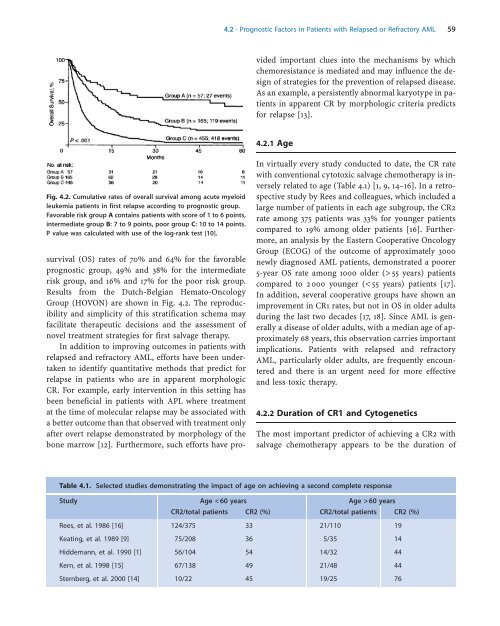Acute Leukemias - Republican Scientific Medical Library
Acute Leukemias - Republican Scientific Medical Library
Acute Leukemias - Republican Scientific Medical Library
Create successful ePaper yourself
Turn your PDF publications into a flip-book with our unique Google optimized e-Paper software.
a 4.2 · Prognostic Factors in Patients with Relapsed or Refractory AML 59<br />
Fig. 4.2. Cumulative rates of overall survival among acute myeloid<br />
leukemia patients in first relapse according to prognostic group.<br />
Favorable risk group A contains patients with score of 1 to 6 points,<br />
intermediate group B: 7 to 9 points, poor group C: 10 to 14 points.<br />
P value was calculated with use of the log-rank test [10].<br />
survival (OS) rates of 70% and 64% for the favorable<br />
prognostic group, 49% and 38% for the intermediate<br />
risk group, and 16% and 17% for the poor risk group.<br />
Results from the Dutch-Belgian Hemato-Oncology<br />
Group (HOVON) are shown in Fig. 4.2. The reproducibility<br />
and simplicity of this stratification schema may<br />
facilitate therapeutic decisions and the assessment of<br />
novel treatment strategies for first salvage therapy.<br />
In addition to improving outcomes in patients with<br />
relapsed and refractory AML, efforts have been undertaken<br />
to identify quantitative methods that predict for<br />
relapse in patients who are in apparent morphologic<br />
CR. For example, early intervention in this setting has<br />
been beneficial in patients with APL where treatment<br />
at the time of molecular relapse may be associated with<br />
a better outcome than that observed with treatment only<br />
after overt relapse demonstrated by morphology of the<br />
bone marrow [12]. Furthermore, such efforts have pro-<br />
vided important clues into the mechanisms by which<br />
chemoresistance is mediated and may influence the design<br />
of strategies for the prevention of relapsed disease.<br />
As an example, a persistently abnormal karyotype in patients<br />
in apparent CR by morphologic criteria predicts<br />
for relapse [13].<br />
4.2.1 Age<br />
In virtually every study conducted to date, the CR rate<br />
with conventional cytotoxic salvage chemotherapy is inversely<br />
related to age (Table 4.1) [1, 9, 14–16]. In a retrospective<br />
study by Rees and colleagues, which included a<br />
large number of patients in each age subgroup, the CR2<br />
rate among 375 patients was 33% for younger patients<br />
compared to 19% among older patients [16]. Furthermore,<br />
an analysis by the Eastern Cooperative Oncology<br />
Group (ECOG) of the outcome of approximately 3000<br />
newly diagnosed AML patients, demonstrated a poorer<br />
5-year OS rate among 1000 older (> 55 years) patients<br />
compared to 2 000 younger (< 55 years) patients [17].<br />
In addition, several cooperative groups have shown an<br />
improvement in CR1 rates, but not in OS in older adults<br />
during the last two decades [17, 18]. Since AML is generally<br />
a disease of older adults, with a median age of approximately<br />
68 years, this observation carries important<br />
implications. Patients with relapsed and refractory<br />
AML, particularly older adults, are frequently encountered<br />
and there is an urgent need for more effective<br />
and less toxic therapy.<br />
4.2.2 Duration of CR1 and Cytogenetics<br />
The most important predictor of achieving a CR2 with<br />
salvage chemotherapy appears to be the duration of<br />
Table 4.1. Selected studies demonstrating the impact of age on achieving a second complete response<br />
Study Age 60 years<br />
CR2/total patients CR2 (%) CR2/total patients CR2 (%)<br />
Rees, et al. 1986 [16] 124/375 33 21/110 19<br />
Keating, et al. 1989 [9] 75/208 36 5/35 14<br />
Hiddemann, et al. 1990 [1] 56/104 54 14/32 44<br />
Kern, et al. 1998 [15] 67/138 49 21/48 44<br />
Sternberg, et al. 2000 [14] 10/22 45 19/25 76
















